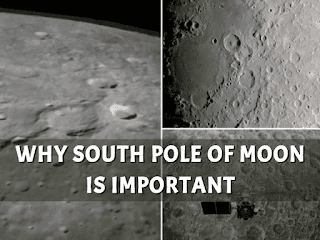The South Pole of the Moon has flooded into the spotlight lately, basically because of its guessed stores of lunar water. As of August 2023, space organizations overall have their eyes fixed on this area, stamping it as a basic point of convergence for lunar investigation.
Water, frequently named as the 'fluid gold' in space situations, holds huge importance. In a climate where supporting human existence presents considerable difficulties, lunar water could upset space missions by offering rocket fuel, breathable oxygen, and hydration for space explorers. Thus, the South Pole of the Moon remains as a reference point of key significance for future endeavors into space.
Summary of why south pole of moon is important
| Topic | Significance |
|---|---|
| Lunar Water | Potential source of rocket fuel, oxygen, and hydration for astronauts. |
| South Pole’s Strategic Position | Presence of water, metals, and minerals. |
| Chandrayaan-3’s Mission | India’s attempt to land on and explore the Moon’s South Pole. |
| Exploratory Objectives | Understand lunar water origins, lunar soil composition, and potential life. |
| International Moon Race | Multiple nations vying to explore the South Pole. |
| India’s Space Ambitions | Chandrayaan-3 as a step towards India’s dominance in space exploration. |
The meaning of water goes past its life-supporting properties. At the point when in space, it means expected fuel, breathable oxygen, and obviously, a wellspring of hydration for space explorers. Lunar water's presence on the Moon, not being limited by Earth's gravitational power, can be all the more effectively used or moved to additional areas in space. It's likened to finding another mother lode, taking into account its enormous potential.
Why the South Pole?
Forever shadowed cavities watch the Moon's South Pole, safeguarding water from dissipation and other unstable elements. These pits, accepted to hold onto lunar water, act as likely spots for lunar mining tasks. Past water, the South Pole could likewise contain essential metals and minerals, adding one more layer of impetus for investigation.
Chandrayaan-3: Taking a Jump Forward
India's Chandrayaan-3, planned for a 2023 send off, expects to investigate this gold mine. As India's third lunar mission, its essential objective is arriving on the South Pole and leaving an imprint in the continuous space race. Furnished with cutting edge instruments, the mission expects to disentangle the Moon's secret privileged insights.
Diving into the Unexplored world
Chandrayaan-3 conveys with it a bunch of goals. From understanding how lunar water got to its resting spot to investigating any expected hints of life or understanding the lunar soil's sythesis, the mission is equipped to respond to a few consuming inquiries.
The Worldwide Moon Rush
India isn't the only one in this lunar mission. The space race is in max speed with nations like China, Russia, and the USA arranging their particular missions to the Moon's South Pole. This worldwide rush highlights the area's importance and its significant job in future space attempts.
India's Cosmic Dreams
The Chandrayaan-3 mission is only one piece of India's more extensive space vision. With goals to be a prevailing power in space investigation, the Indian Space Exploration Association (ISRO) has large plans, and an effective South Pole landing would be a credit to its.
Wrapping Up
To comprehend the reason why the South Pole of the Moon is significant is to perceive mankind's longing for investigation and food in space. As the mission proceeds, one thing is clear: lunar water and the Moon's South Pole will be instrumental in prearranging the following section of room investigation.
FAQs:
Q: How important is lunar water?
A: Lunar water is similar to gold in space, fundamental for fuel, oxygen, and hydration.
Q: For what reason is the Moon's South Pole focused on for investigation?
A: Facilitating stores of lunar water and other fundamental resources is accepted.
Q: What are the targets of the Chandrayaan-3 mission?
A: It means to investigate the Moon's South Pole, figure out the beginning of lunar water, and look at the lunar soil's structure.
Q: Who are the key part in the ongoing space rush to the Moon's South Pole?
A: India, China, Russia, and the USA are effectively arranging missions toward the South Pole of the Moon.







0 Comments
if you have any doubts, please let me know